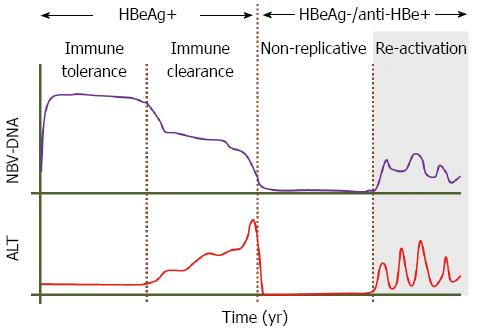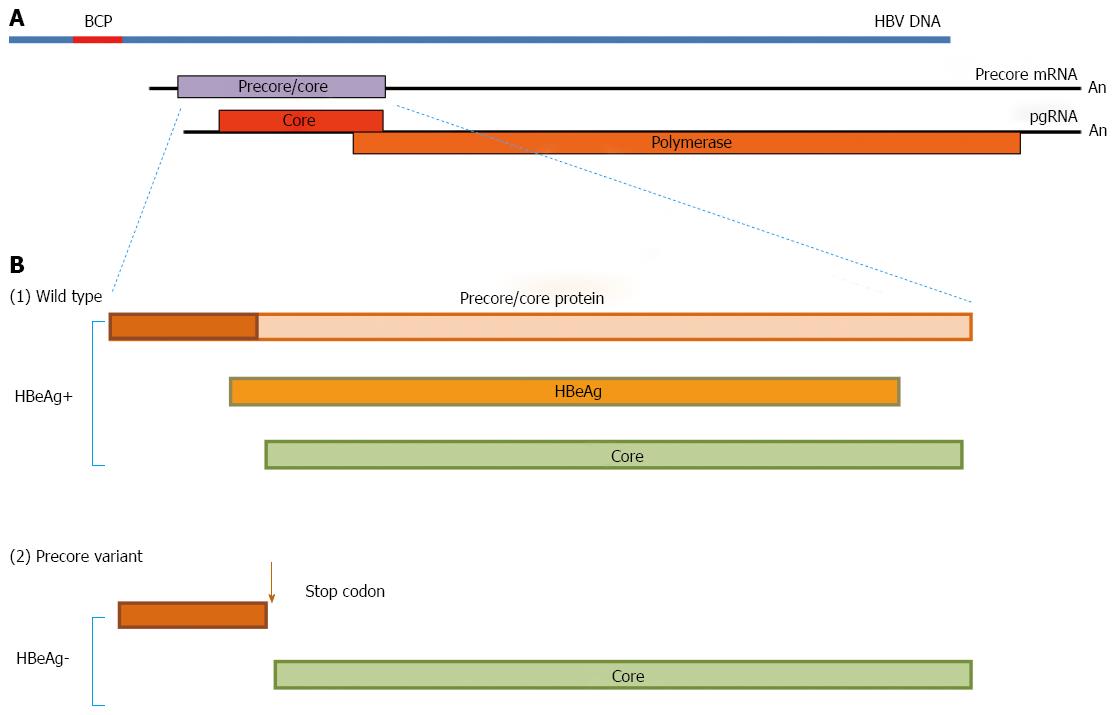Copyright
©2014 Baishideng Publishing Group Inc.
World J Gastroenterol. Jun 28, 2014; 20(24): 7644-7652
Published online Jun 28, 2014. doi: 10.3748/wjg.v20.i24.7644
Published online Jun 28, 2014. doi: 10.3748/wjg.v20.i24.7644
Figure 1 Course of the natural history of hepatitis B virus infection showing the four possible phases of disease.
These are referred to as the immune tolerant, the immune clearance, the non-replicative (inactive) and the reactivation phase characterized by increased viral replication and liver damage (shaded area). During the first two phases the patient is hepatitis B e antigen (HBeAg) positive and negative during the last two. Moreover, the wild type hepatitis B virus (HBV) is dominant in the Immune tolerant and immune clearance phases, whilst the precore and basic core promoter variants are the main isolates seen in patients during the reactivation phase, and such patients constitute the HBeAg negative chronic hepatitis B group. Patients in the immune clearance and the reactivation phases are at greater risk of developing cirrhosis and eventually hepatocellular carcinoma. ALT: Alanine aminotransferase.
Figure 2 Protein products encoded by the precore/core open reading frames in wild type and precore stop codon variant isolates.
A: The 3.2 kb in length HBV DNA genome in linear form (normally circular as cccDNA) and the two longer than genome length precore mRNA and pgRNA, the transcription of which is under the control of the BCP. The transcripts encoding for HBsAg and HBxAg are not shown. The precore mRNA encodes for the precore/core protein (grey open reading frame) and the pgRNA for the core and polymerase (red and orange open reading frames); B: Effect of the precore stop codon mutation on HBeAg production in comparison to that of the wild type virus. The precore/core protein is the precursor of HBeAg and consists of the precore region (in brown) and the core encoding region (in pink). HBeAg is formed through proteolytic cleavage of both its amino- and carboxyl-ends (see text). The presence of the stop codon mutation leads to the abrogation of HBeAg production as a result of pre-mature termination of the synthesis of the precore/core precursor as shown. HBcAg synthesis on the other hand which utilises the pgRNA transcript remains unaffected, thus permitting continued virion production. Please note that the proteins share complete amino acid homology over the overlapped regions. Yet, HBeAg and HBcAg display different antigenic epitopes. ALT: Alanine aminotransferase; HBeAg: Hepatitis B e antigen; HBV: Hepatitis B virus; HBsAg: Hepatitis B surface antigen; BCP: Basic core promoter; HBcAg: Hepatitis B c Antigen; HBxAg: Hepatitis B x Antigen.
- Citation: Alexopoulou A, Karayiannis P. HBeAg negative variants and their role in the natural history of chronic hepatitis B virus infection. World J Gastroenterol 2014; 20(24): 7644-7652
- URL: https://www.wjgnet.com/1007-9327/full/v20/i24/7644.htm
- DOI: https://dx.doi.org/10.3748/wjg.v20.i24.7644










